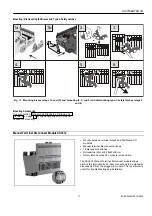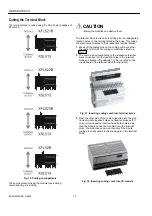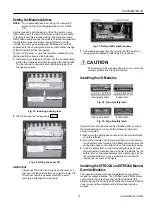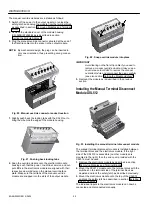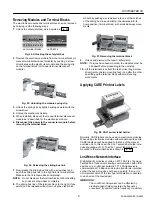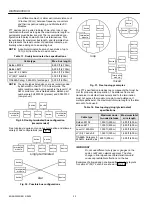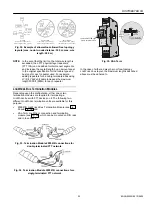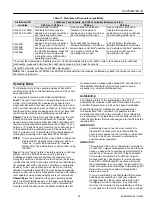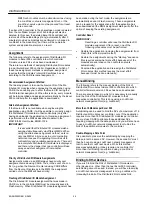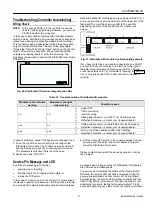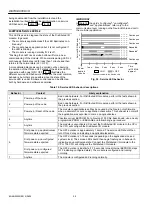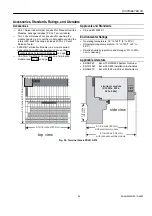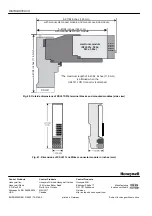
DISTRIBUTED I/O
25
EN0B-0090GE51 R0802
Table 17. Distributed I/O module compatibility
L
ON
W
ORKS
Functionality, by XL500 controller firmware version
Distributed I/O
modules
V2.00.xx to V2.03.xx
V2.04.xx
V2.06.xx
XFL521, XFL522A,
XFL523, XFL524A
One controller to which
Distributed I/O modules are
assigned on a single L
ON
W
ORKS
bus; operating mode: local
One controller to which Dis-
tributed I/O modules are
assigned on a single L
ON
W
ORKS
bus; operating mode: local
One controller to which Dis-
tributed I/O modules are
assigned on a single L
ON
W
ORKS
bus; operating mode: local
XFL521B,
XFL522B,
XFL523B,
XFL524B
One controller to which
Distributed I/O modules are
assigned on a single L
ON
W
ORKS
bus (if you wish to enable this
backwards-compatible mode
1
for
the XFL52xB modules, press the
L
ON
W
ORKS
service pin while
turning the rotary HEX switch);
operating mode: local
Full L
ON
W
ORKS
functionality:
Multiple Distributed I/O modules
and multiple controllers
2
possible
on a single L
ON
W
ORKS
bus;
operating mode: open
Full L
ON
W
ORKS
functionality:
Multiple Distributed I/O modules
and multiple controllers
2
possible
on a single L
ON
W
ORKS
bus;
operating mode: open
1
To cancel the backwards-compatible mode for XFL52xB modules (date code: 4400 or later), thus allowing full L
ON
W
ORKS
functionality, press and hold down the L
ON
W
ORKS
service pin for at least 3 seconds.
2
Excel 500 controller with Neuron 3120E5 chip required!
NOTE:
The compatibility of XFR522A and XFR524A Manual Override modules is affected by neither the firmware version nor
the Neuron chip version.
Operating Modes
The following refers to the operating modes of Excel 500
controllers into which controller firmware version 2.04.xx has
been downloaded.
It is important to remember the following definitions:
Local:
The term "local" refers to an operating mode in which
a max. of 16 Distributed I/O modules are connected to a
single host Excel 500 controller via a L
ON
W
ORKS
bus, and in
which
no other
devices co-exist on that bus. In this mode, the
Distributed I/O modules are assigned to their host Excel 500
controller automatically, and autobinding is performed.
Shared:
The term "shared" means that, aside from the host
Excel 500 controller and its Distributed I/O modules,
other
devices
(which may include other Excel 500 controllers with
their own Distributed I/O modules, Excel 50 or Excel 10 con-
trollers, or 3
rd
-party devices) co-exist on the L
ON
W
ORKS
bus.
In the shared mode, autobinding may still be used for the
NVs of a maximum of 16 Distributed I/O modules assigned
(manually) exclusively to the host Excel 500 controller.
NOTE:
It is recommended that you use CARE to assign the
Distributed I/O modules to the host Excel 500 con-
troller (i.e. to enter the Distributed I/O modules'
Neuron IDs). The alternative is to assign them using
the MMI.
Open:
The term "open" refers to an
interoperable
L
ON
W
ORKS
system in which CARE has been used to generate a
L
ON
M
ARK
-compliant network interface file capable of pro-
viding NVs which can be bound to other devices (which may
include other Excel 500 controllers with their own Distributed
I/O modules, Excel 50 or Excel 10 controllers, or third-party
devices). In the open operating mode, the NVs of the Dis-
tributed I/O modules exceeding 16 must be bound manually
using a L
ON
W
ORKS
network management tool (an LNS-based
tool capable of using Honeywell plug-ins is recommended).
Shared/Open:
The
shared and the open operating modes
can be in effect simultaneously. In this case, autobinding is
performed for the NVs of a maximum of 16 Distributed I/O
modules, while the data points of additional Distributed I/O
modules must be mapped with shared NVs, and the NVs of
the additional Distributed I/O modules must be bound
manually (e.g. using an LNS-based tool).
Autobinding
The following refers to the autobinding of the NVs of
Distributed I/O modules to Excel 500 controllers into which
controller firmware version 2.04.xx has been downloaded.
When Distributed I/O modules are used exclusively by
Honeywell Excel 500 controllers, it is possible to auto-
matically bind their NVs to the controller. This is referred to
as "autobinding." In autobinding, each controller on the bus
finds the Distributed I/O modules assigned to it and binds the
required NVs.
IMPORTANT:
Autobinding does not work across routers. Dis-
tributed I/O modules must be located within the
same router segment as the controller to which their
NVs are to be bound. However, autobinding
is
possible across repeaters.
IMPORTANT:
The autobound NVs of a controller are not visible to
a L
ON
W
ORKS
network management tool, and there is
hence no danger that a careless user will attempt to
re-bind them. However, the NVs of the Distributed
I/O modules are visible to a L
ON
W
ORKS
network
management tool. Any attempt to re-bind the auto-
bound NVs of Distributed I/O modules will corrupt
the autobindings. In such a case, the Excel 500 con-
troller will restore the autobindings automatically, but
there will be numerous system and application
alarms as a result.
If, prior to autobinding, the Distributed I/O modules
have been accessed by a L
ON
W
ORKS
network
management tool, the modules will remain in the
“configured” mode. In this state, they cannot be
found by the controller during autobinding, and they
do not appear in the list of modules on the controller







